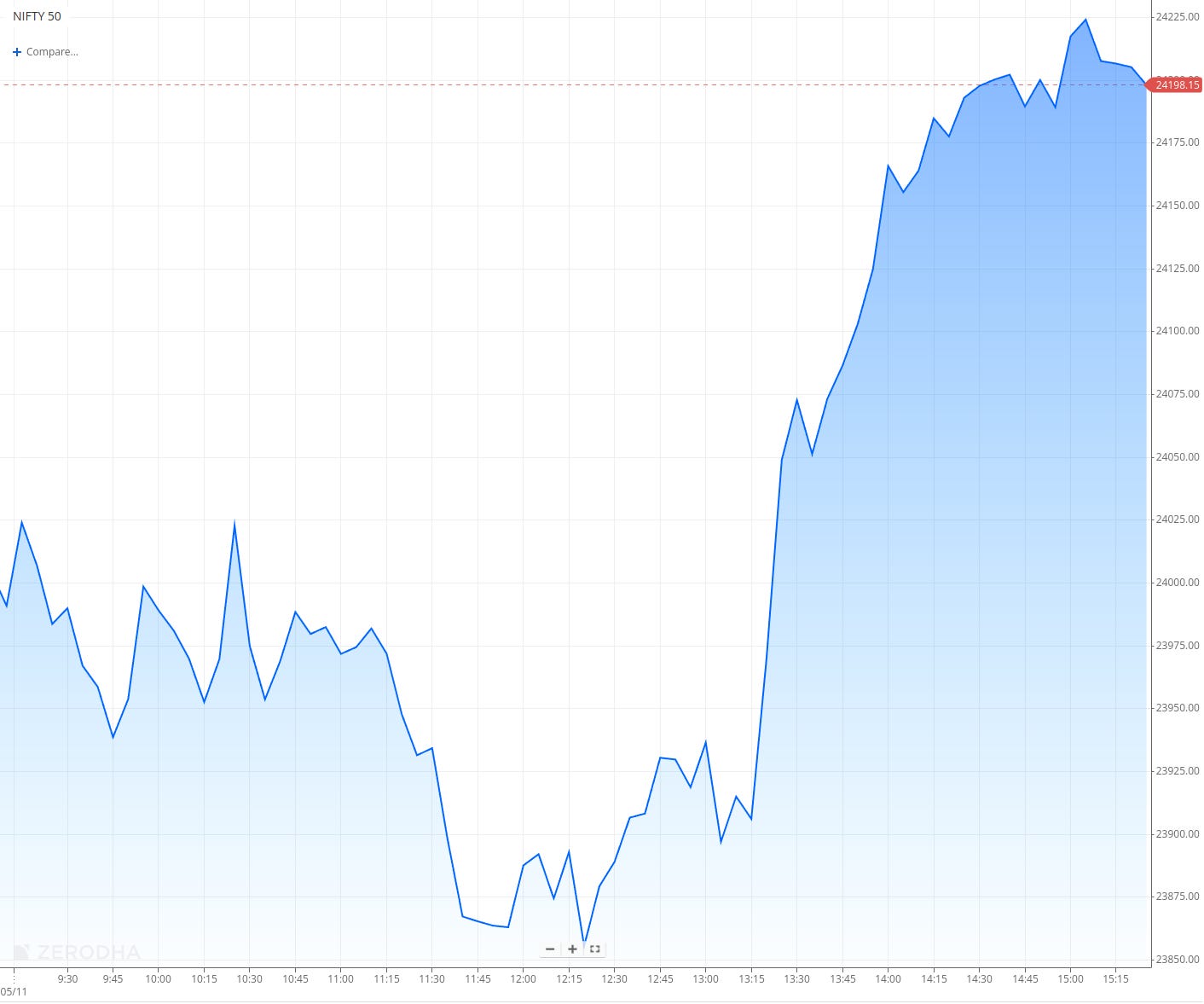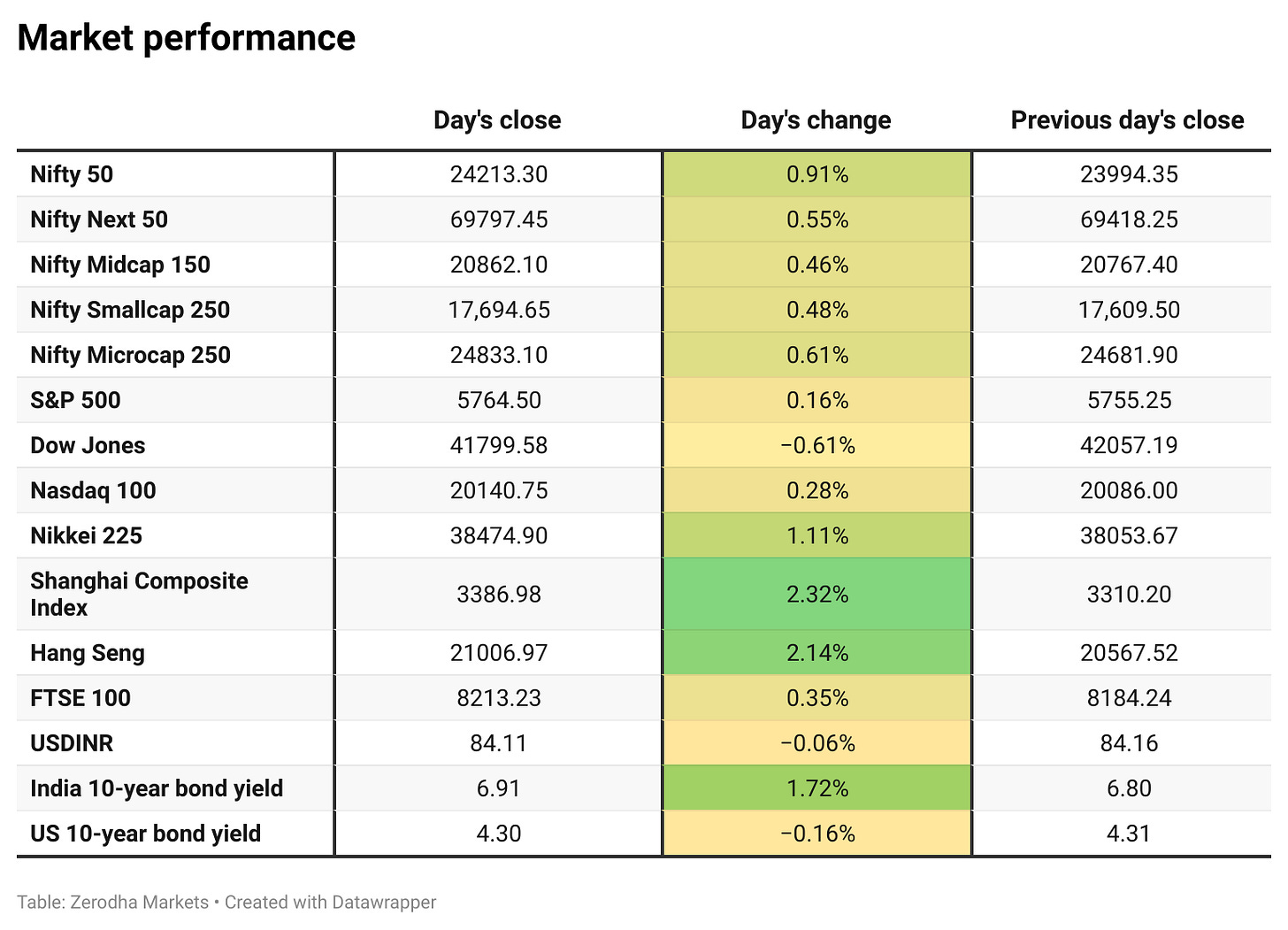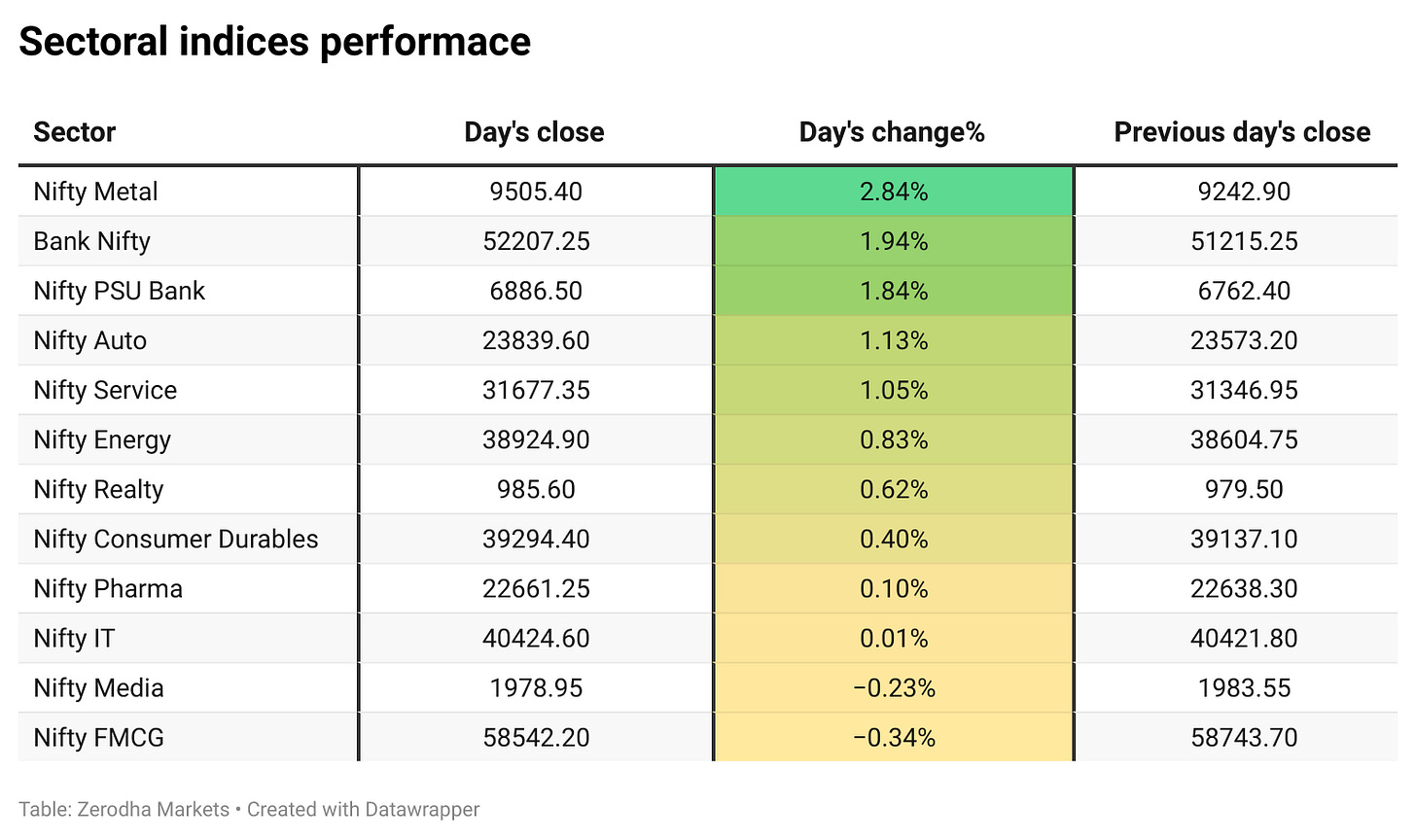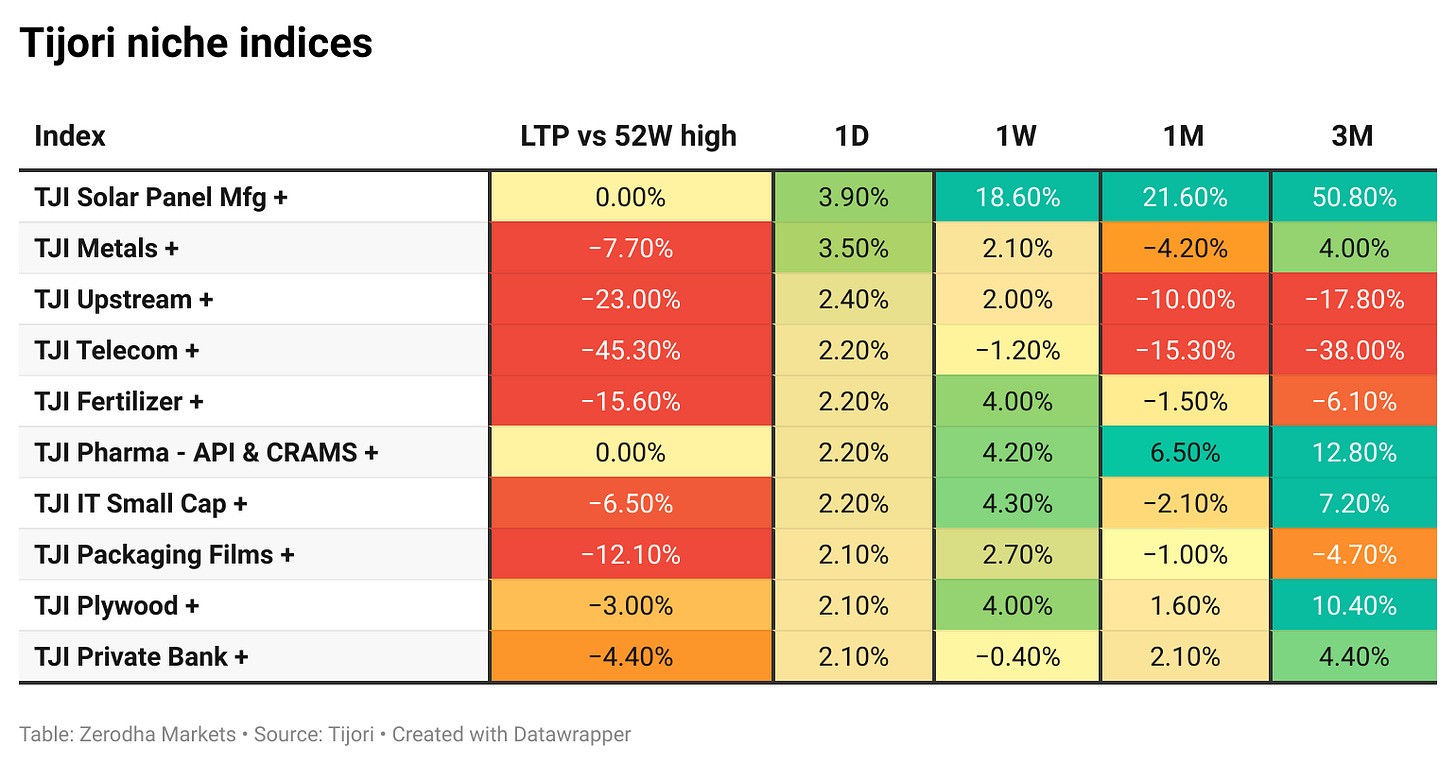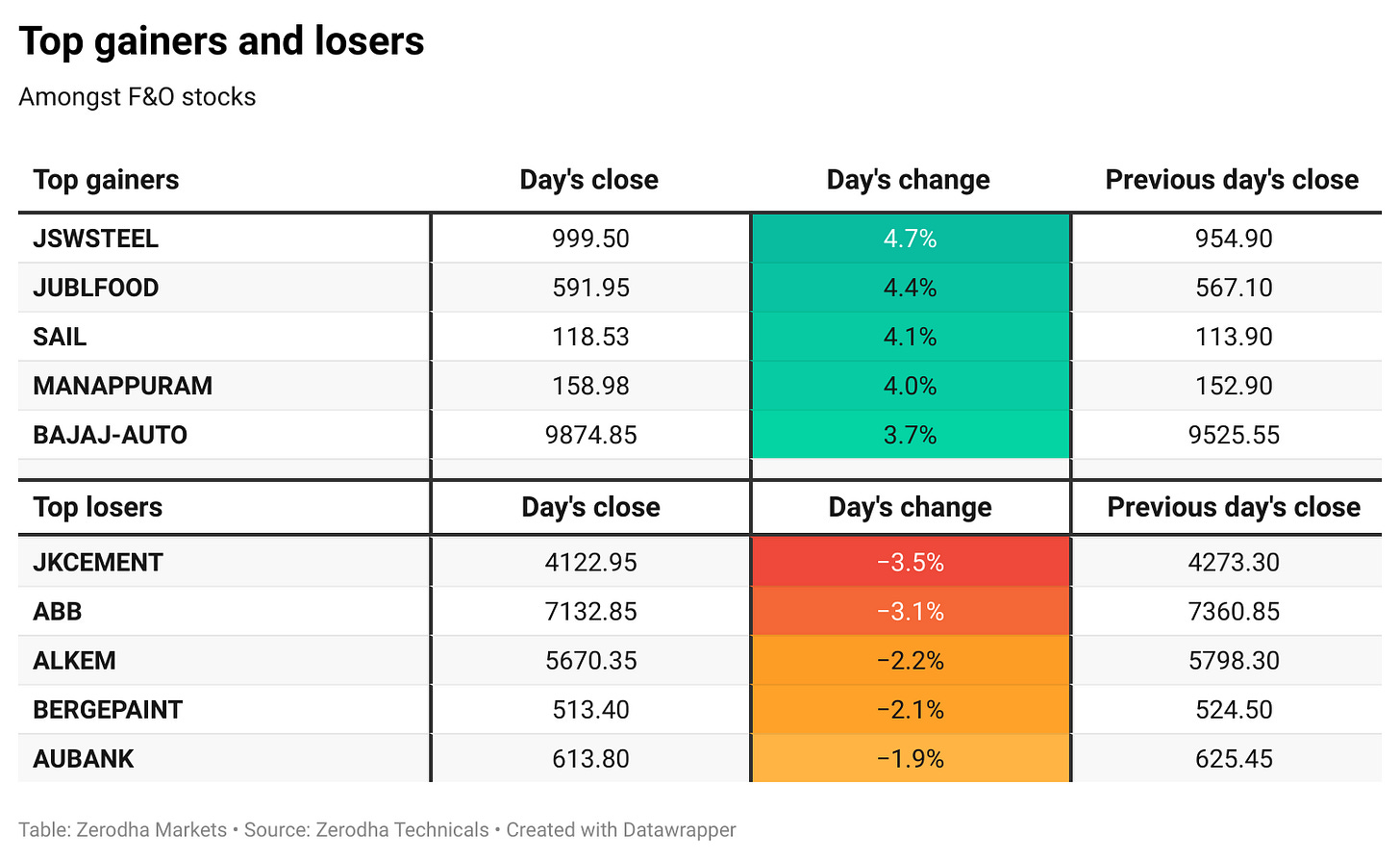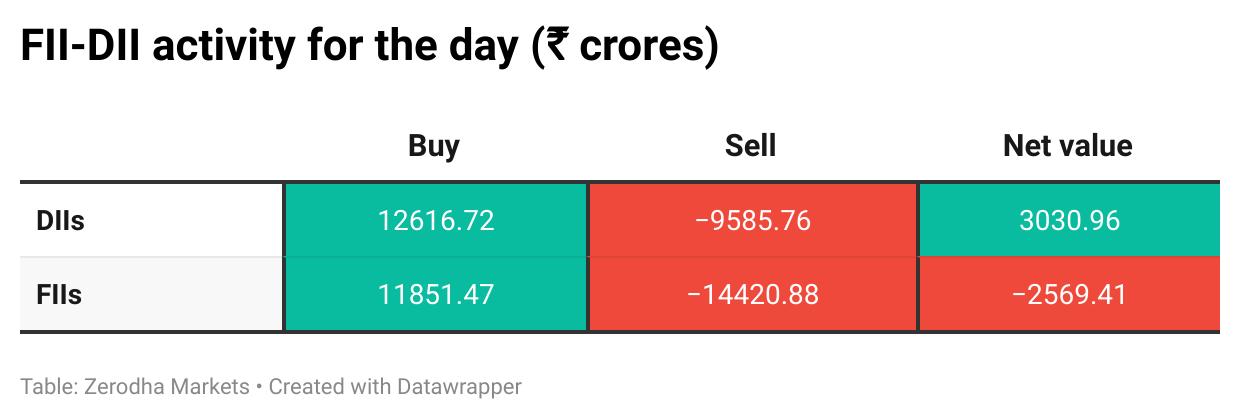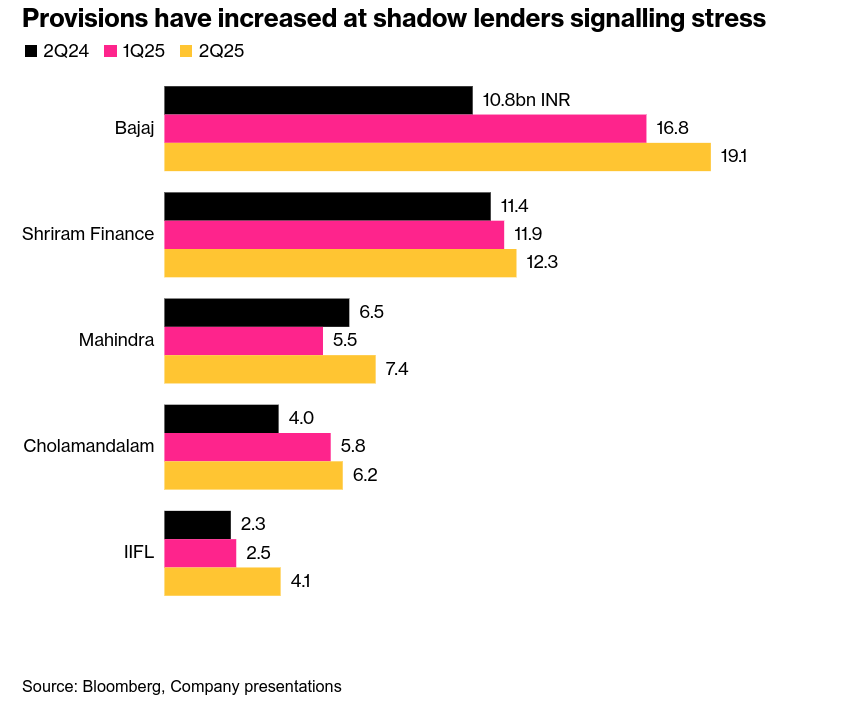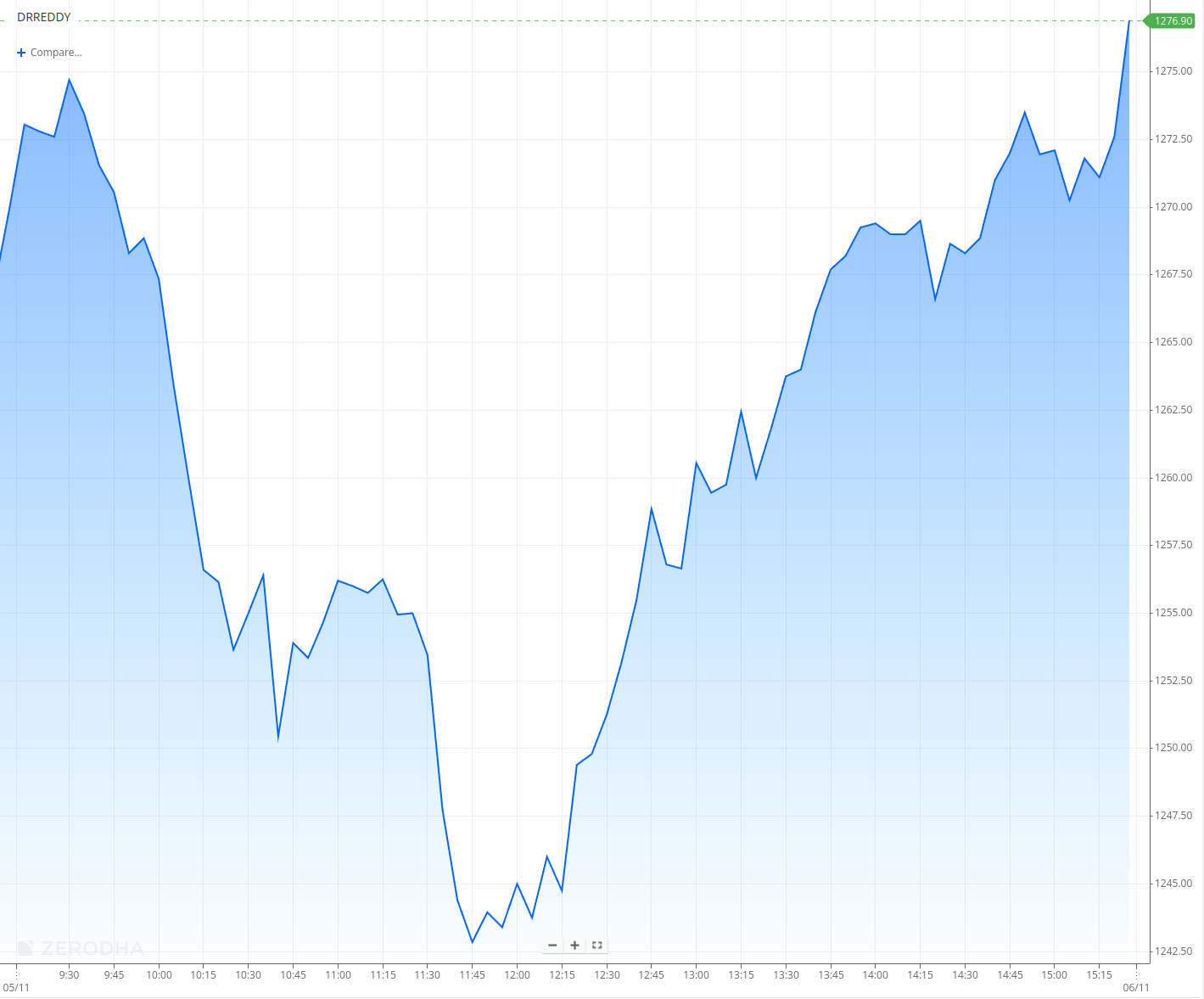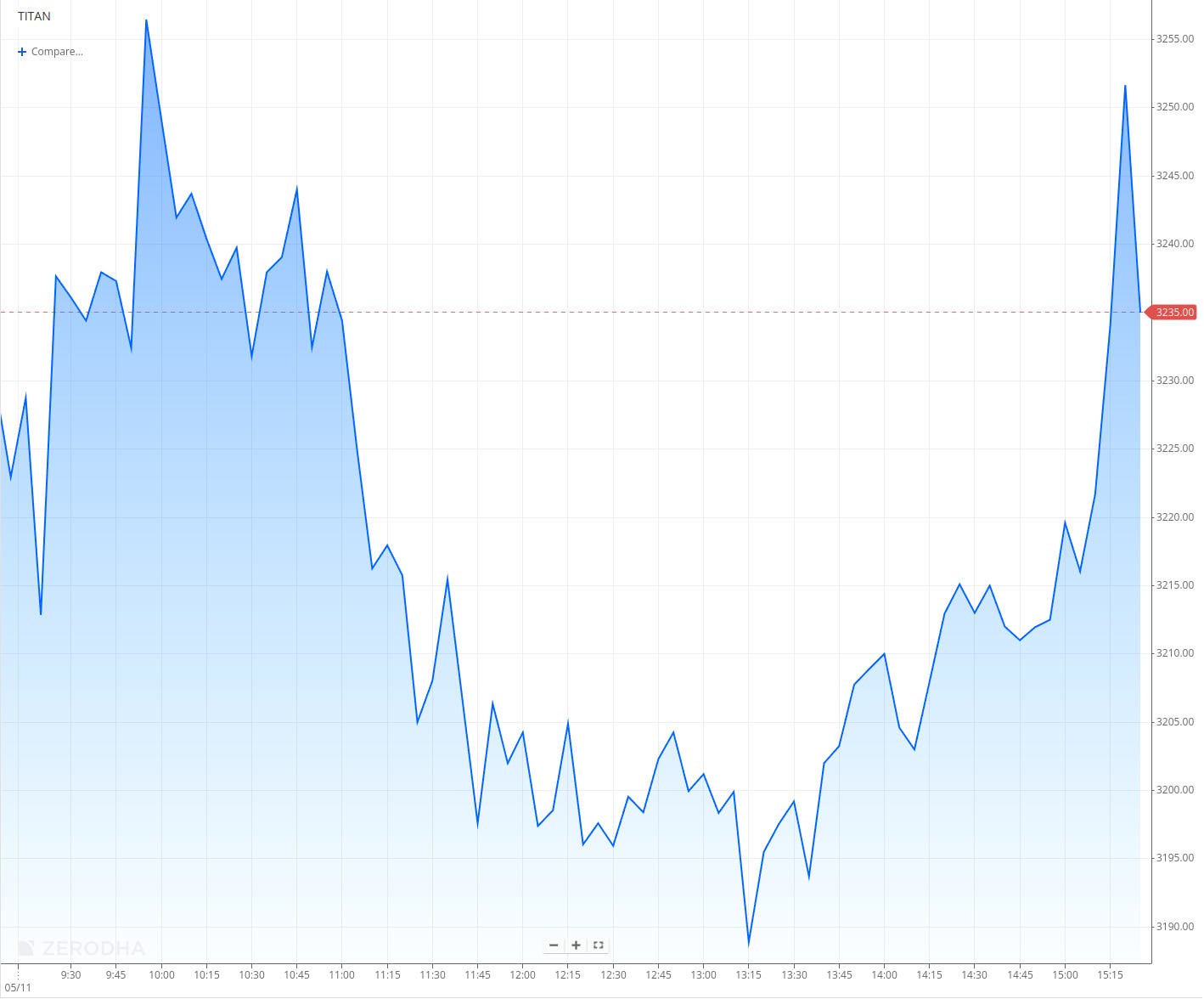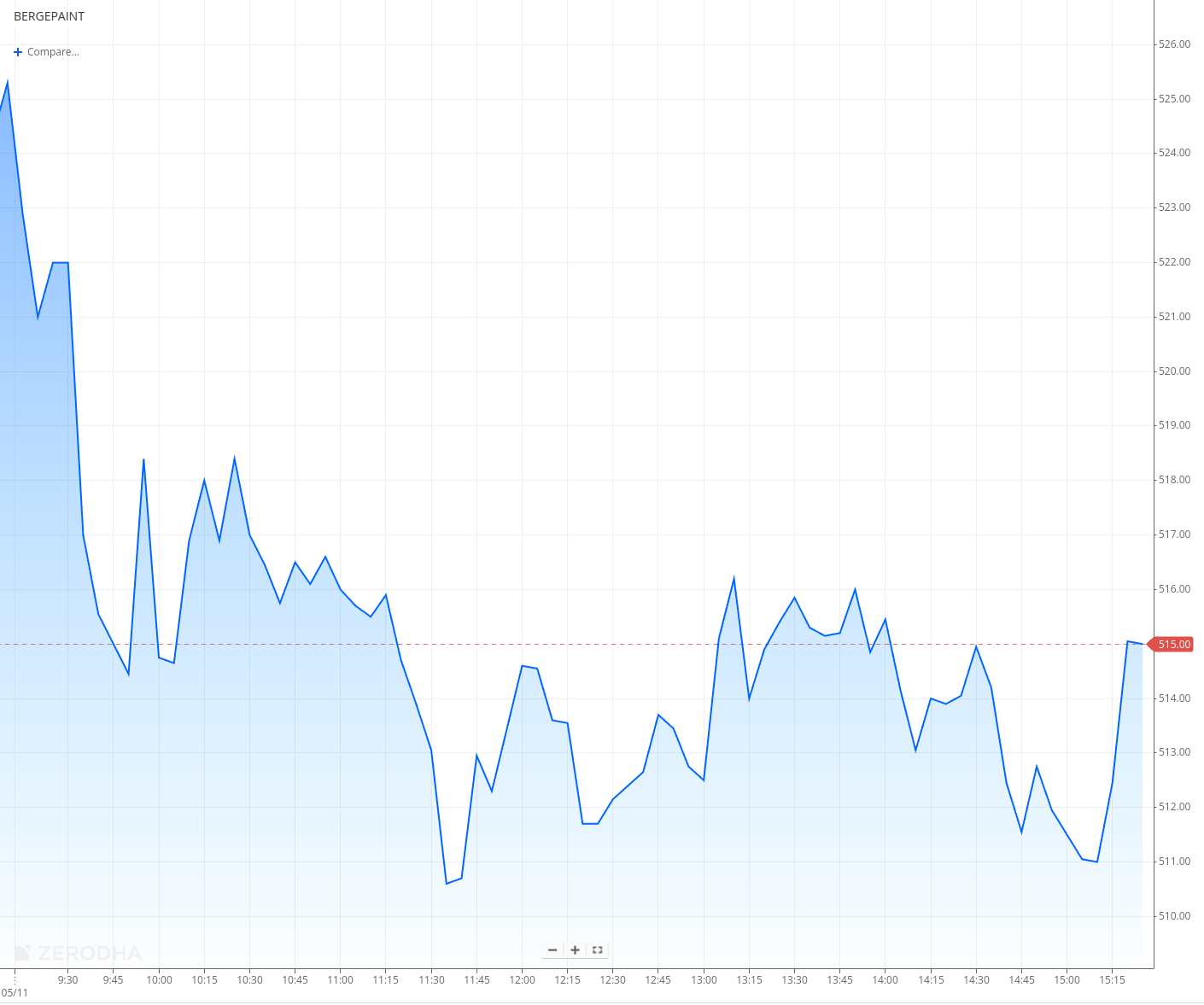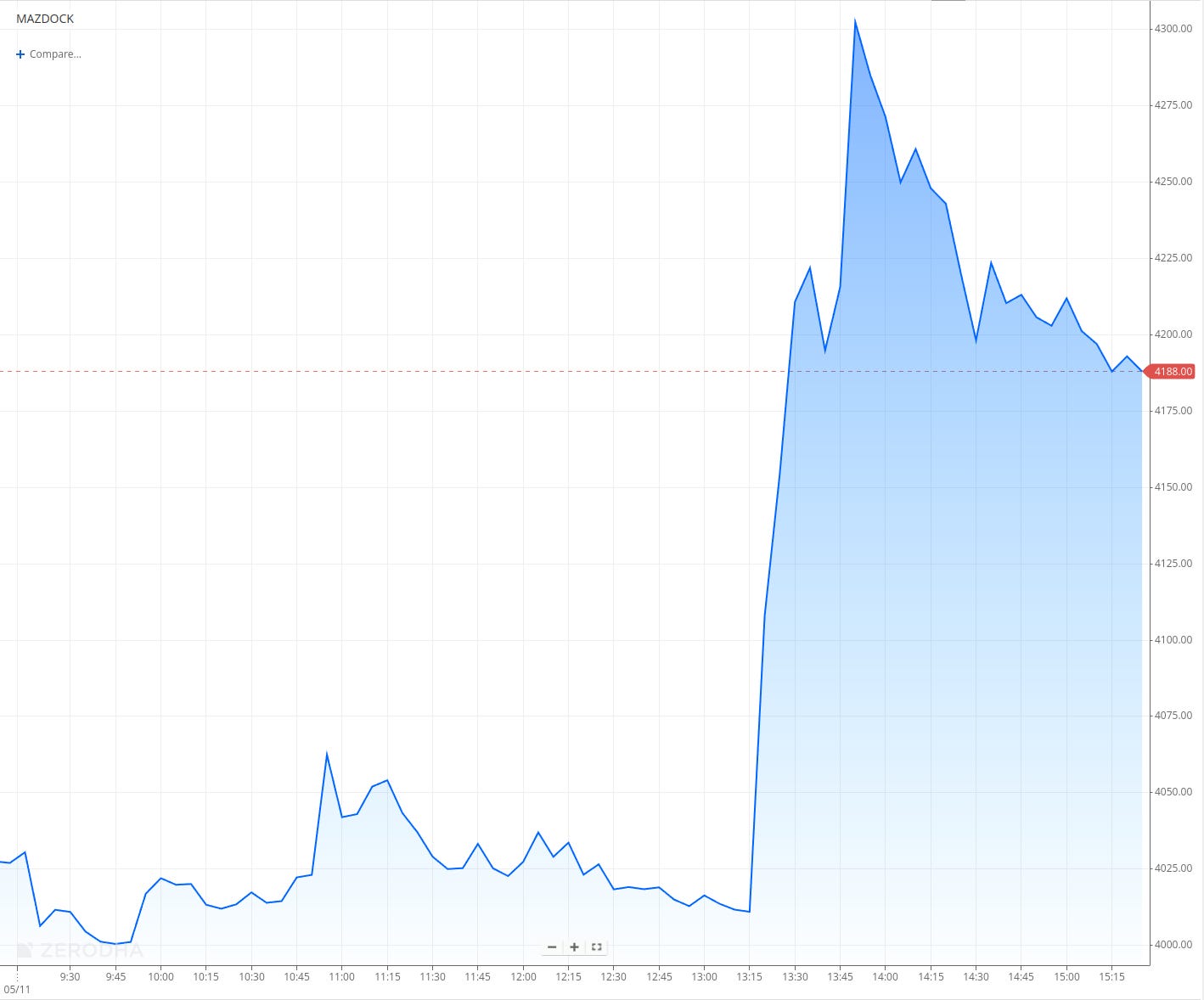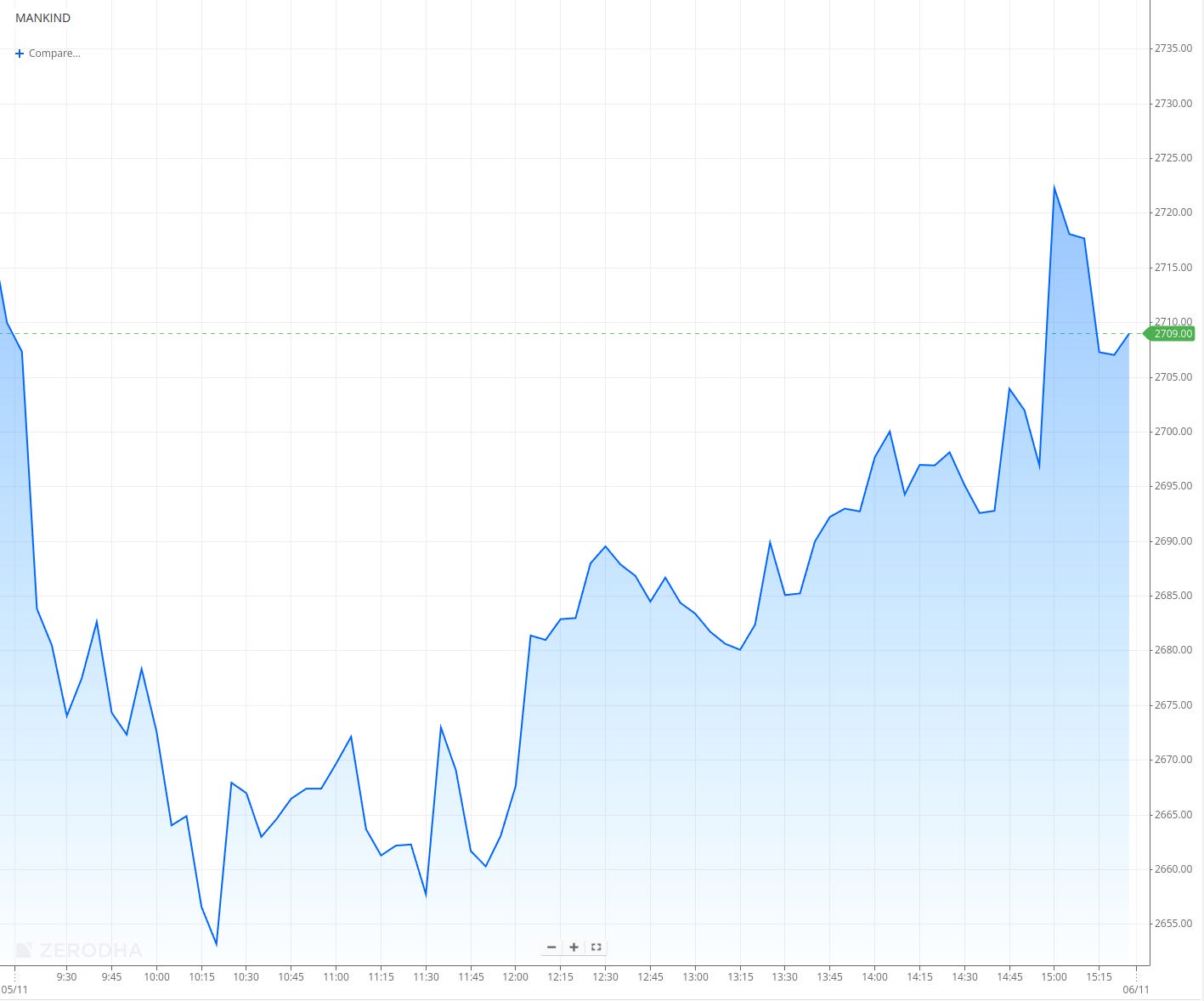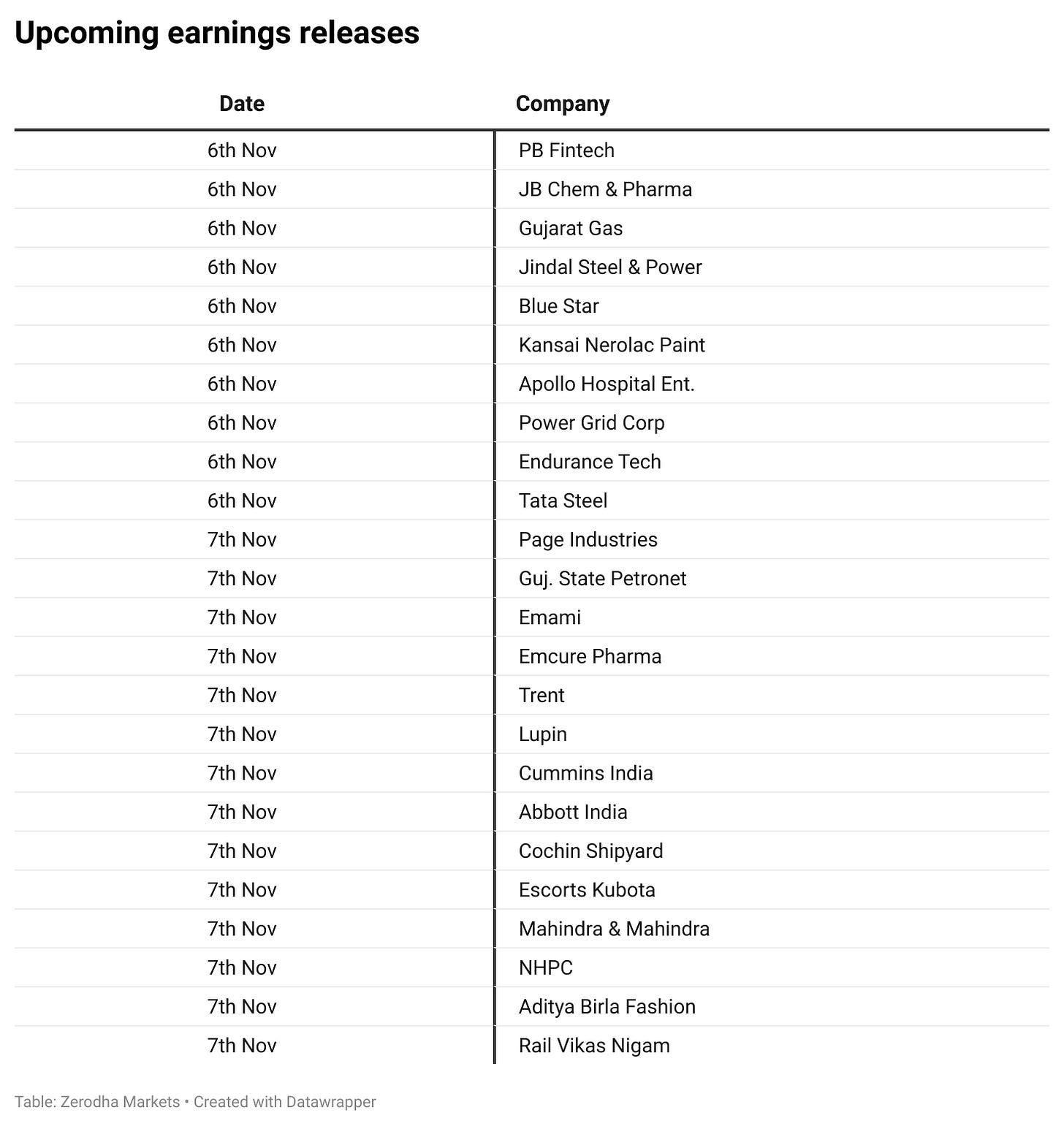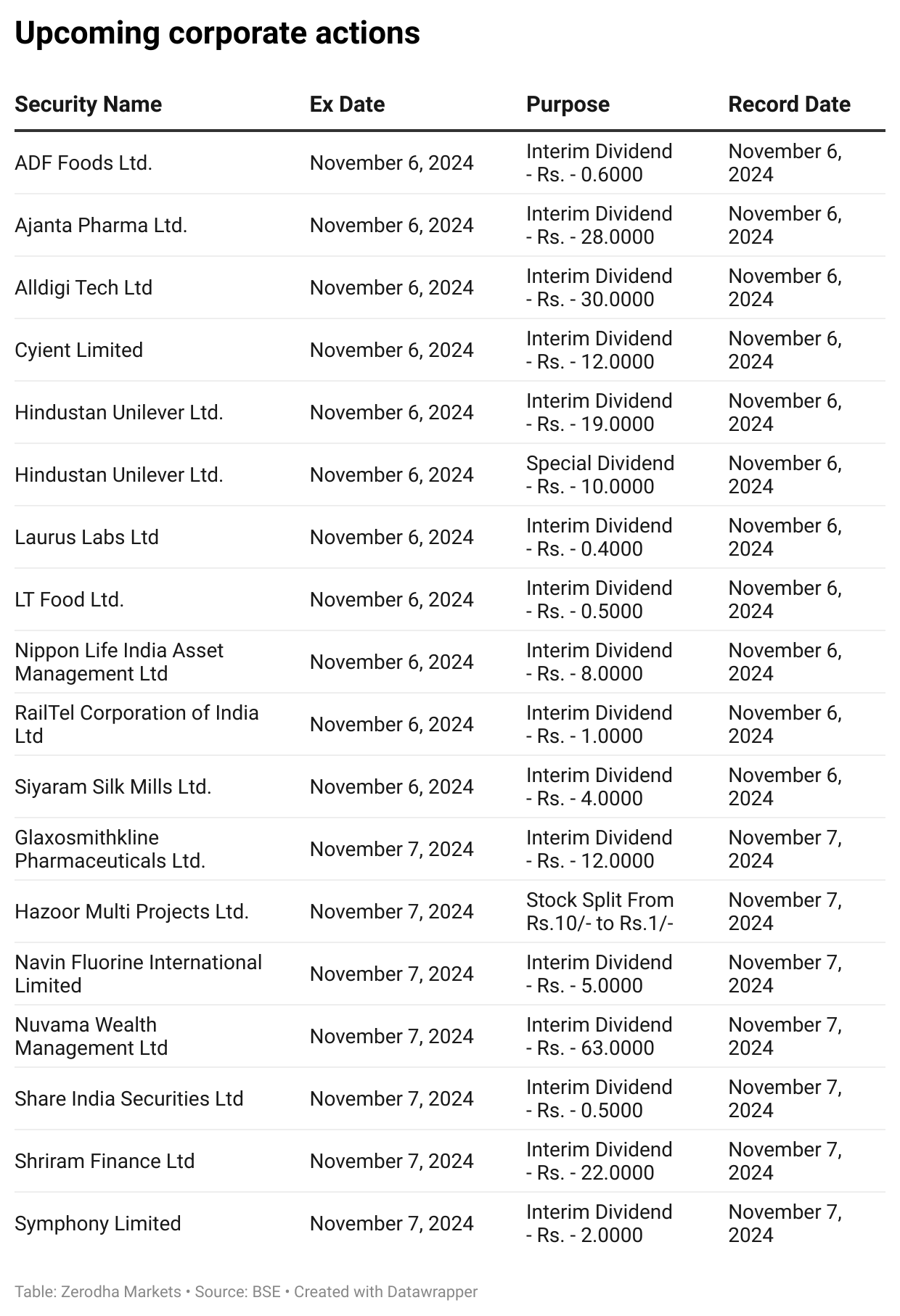Welcome to Aftermarket Report, a newsletter where we do a quick daily wrap-up of what happened in the markets—both in India and globally.
Market overview
Indian markets ended the day in the green today after yesterday’s selloff, mirroring sentiment in the global markets ahead of the US elections. Nifty 50 index was up ~217 points or ~0.91% for the day.
The sentiment was positive across the broader market, with 1.7 stocks advancing for early one stock declining (1761 advances to 1042 declines).
Tijori is an investment research platform, and they have constructed niche indices for various themes and sub-sectors. They help you get a sense of the market performance of narrow slices of the market.
What’s happening in India
Regulator demands ₹130 crore for Reliance fund misuse
SEBI has fined five firms Rs. 130 crore for illegally transferring funds from Reliance Home Finance Ltd. Netizen Engineering, Citi Securities, and three other firms must each pay Rs. 26 crore within 15 days. If they fail to pay, SEBI will seize their assets and bank accounts.
Why?
SEBI banned Anil Ambani and 24 others from the securities market for five years in August after discovering they created fake loans to divert funds. The group continued these deceptive practices despite the board’s direct orders to stop.
Source: Economic Times
SEBI takes action against the leadership at Embassy REIT
Embassy REIT shares fell 3% after SEBI suspended CEO Aravind Maiya over major audit issues found by NFRA (National Financial Reporting Authority).
Why?
- The NFRA has found important issues in the audits, raising doubts about the accuracy of financial reports.
- SEBI is enforcing compliance with the “fit and proper” criteria for company leaders.
- This suspension is part of a push for better transparency and responsibility in the financial industry.
Source: Reuters
What’s happening in India’s NBFC sector?
India’s shadow banks (Non-Bank Financial Companies) are struggling as companies like Bajaj Finance, Shriram Finance, and Mahindra Financial report more unpaid loans. This has hurt their stock prices and drawn attention from regulators. The RBI has stepped in by stopping some shadow banks from giving new loans and requiring them to keep more cash reserves. The sector’s lending growth has slowed to 12.8% compared to last year.
Why?
Growing loan defaults are raising red flags about financial health. As borrowers struggle to repay debts, lenders have become more cautious. The RBI is tightening oversight to prevent another sector crisis.
Source: Bloomberg
Quarterly results
In this section, we’ll dive into all the key highlights from today’s intriguing results, covering the most impactful performances and standout moments. The numbers are comparable on a year-on-year (YoY) basis.
Dr Reddy’s Lab (+0.31%)
What happened:
- Consolidated net profit fell 15% YoY to ₹1,255 crore.
- Revenue from operations increased 17% YoY to ₹8,016 crore.
- EBITDA rose 5% YoY to ₹2,280 crore, with margins improving to 28.4%.
Why?
- Global generics revenue grew 17% YoY to ₹7,160 crore, supported by higher sales volumes and new product launches.
- Four new products were launched in North America, contributing to revenue growth.
Titan (+0.26%)
What happened:
- Revenue increased 16% YoY to ₹14,534 crore, up from ₹12,529 crore.
- Net profit declined 23% YoY to ₹704 crore, compared to ₹916 crore.
- EBITDA dropped 12% YoY to ₹1,236 crore, down from ₹1,411 crore.
- EBITDA margin fell to 8.5% from 11.3%.
Why?
- Revenue increased as demand grew following customs duty reduction, leading to 12% more buyers and a 10% rise in average selling price (ASP).
- Lower customs duty on gold affected revenue by ₹290 crore during Q2.
Berger Paints (-2.12%)
What happened:
- Net profit declined 7.5% YoY to ₹269.6 crore.
- Revenue from operations rose slightly by 0.3% YoY to ₹2,774.6 crore.
- EBITDA dropped 8.3% YoY to ₹434.2 crore, with a margin of 15.7%.
Why?
- Volume growth was impacted by extended monsoon and flooding.
- Margins were affected by increased investments in construction chemicals, waterproofing, and higher advertising costs.
Mazagon Dock Shipbuilders (+4.24%)
What happened:
- Q2 FY25 PAT rose 75.7% YoY to ₹585 crore from ₹332.9 crore.
- Revenue from operations increased 50.8% YoY to ₹2,756.8 crore.
- EBITDA grew 189.1% YoY to ₹511 crore, with margins at 18.5%.
- Total income rose 44.8% YoY to ₹3,011.1 crore.
- Total expenses increased 37.76% YoY to ₹2,270.6 crore.
Why?
- A rise in revenue from operations and improved cost efficiency have boosted profitability.
- Increased EBITDA margins reflect improved cost management.
Mankind Pharma (-0.62%)
What Happened?
- Net profit rose 30% YoY to ₹653 crore.
- EBITDA grew 25% YoY to ₹850.04 crore, up from ₹682.65 crore.
- Total revenue increased by 14%.
Why?
- Increased demand has driven growth in drugs targeting chronic conditions, including diabetes and cardiovascular diseases.
- Strong sales were seen in key products, including contraceptive solutions and diagnostic devices for early detection of pregnancy.
What’s happening globally
FCA brings new rules to improve UK market efficiency
The UK’s financial watchdog Financial Conduct Authority (FCA) has introduced new rules to strengthen bond, derivatives, and asset management markets.
What does this mean?
- Investors will gain more timely and clearer information about bonds and derivatives, which can help lower costs for firms.
- Asset managers will have more flexibility in how they pay for investment research, including the option to combine these payments with trade execution.
The UK plans to boost its financial markets with new transparency rules taking effect in December 2025, aiming to maintain its position as a global financial hub.
Source: Reuters
Yum Brands sees drop in global sales
What is happening:
Yum Brands reported a decline in global same-store sales, driven by sluggish demand at its KFC chain in the U.S., where sales fell 5%, marking a third consecutive quarterly drop. Despite launching new $5 value items under the “Taste of KFC” menu, the brand struggled to keep up in the competitive “value wars” against fast-food giants like McDonald’s and Burger King.
Why?
High menu prices are pushing customers to seek discounts and deals, impacting fast-food chains like KFC. Meanwhile, Taco Bell remains a positive performer for Yum Brands, with U.S. same-store sales rising for the 11th straight quarter. Internationally, Yum Brands faced challenges due to boycotts in response to the Israel-Gaza conflict, affecting sales in multiple markets.
Source: Reuters
EU-China diplomacy continues amid escalating tariff tensions and trade stalemate over EVs
What is happening:
Fears of a growing tariff war are keeping EU-China diplomatic channels open, despite stalled trade talks on electric vehicles (EVs). New EU tariffs on Chinese EVs took effect last week, leading China to retaliate with probes and import curbs on European goods like pork, dairy, and brandy. Meanwhile, some EU member states are using the tensions to strengthen bilateral ties with China, attracting potential investments.
Why?
The EU’s recent tariffs on Chinese EV imports follow claims of unfair subsidies in China’s auto industry, which Beijing disputes. As the U.S. election signals possible increased American trade restrictions on China, the EU aims to prevent a full-blown trade conflict by sustaining diplomatic efforts. Despite tensions, individual EU countries, like France, continue to foster commercial relationships with China, underscoring the complex dynamics at play in EU-China relations.
Source: Reuters
Foxconn reports slower sales growth
What is happening:
Apple’s biggest supplier, Hon Hai (Foxconn), saw its October sales grow 8.6% to $25.2 billion - its weakest growth since February. This slow growth raises questions about holiday season demand.
Why?
- The recent slowdown in sales growth has prompted doubts about the demand for AI infrastructure and iPhones.
- As an important partner for Nvidia, Hon Hai’s performance is closely monitored, adding pressure to its results.
- Major tech companies like Meta and Google are under scrutiny for their spending on servers and data centers.
Source: Bloomberg
Management chatter
In this section, we pick out interesting comments made by the management of major companies.
Krishna Bondanapu, Executive Vice Chairman and Managing Director, Cyient Limited on semiconductors business.
I’ll start with two main points. First, regarding operational and capital expenditures: while I don’t have an exact figure on hand, we’ve previously mentioned that most of the proceeds from the DLM stake sale—nearly $100 million—will be directed towards the semiconductor business. This amount serves as a solid starting point, primarily allocated towards capital expenditures, including acquisitions and other inorganic growth. Much of our own capex is already covered, as we have the necessary equipment in Cyient, which will be transitioned over. Beyond this, we don’t foresee any major additional capex requirements. The Board has approved an allocation of close to $100 million, part of which will also go towards debt repayment.
The second point concerns why this business hasn’t reached its full potential. The real value lies not only in chip design but in both the design and supply of chips. Supplying chips introduces a different cost structure and dynamics, much like we saw previously with the DLM business. Operating as an independent entity, we’ll have a greater capacity to pursue chip sales deals. In the past, we often missed out on deals by declining chip sales or by setting margins that the market considered too high. By addressing this, we can be more competitive in both design and sourcing.
This approach strengthens my confidence in the business. In many ways, the turnkey ASIC (Application-Specific Integrated Circuit) business, with its chip design and sourcing elements, shares similar economic cycles with the DLM business. However, as an independent operation, we’re better positioned to grow more aggressively without the impact on margins that Cyient experienced from the cyclicality and unpredictability of the business.
Sanjay Purohit, CEO and Whole Time Director of Sapphire Foods Indian Limited on weak demand for KFC.
A strong brand with weak appeal are perhaps two ends of the spectrum. I agree that KFC is a very strong brand, but there is still notable competitive intensity, especially within the fried chicken segment. Additionally, KFC competes in the broader restaurant and fast-food category, where other players also pose competition. In a weak demand environment, even a strong brand like KFC can feel the impact.
This year, we’ve been particularly surprised by the significant drop in demand during vegetarian observance days, including in regions like the North, West, and South—especially in Tamil Nadu during the Purattassi festival. Moving forward, after Dussehra and over the next three to four weeks, we’ll gain a clearer view of how demand trends might shape up for the rest of the year.
That said, we’re continuing to invest heavily in the brand. In direct competitive scenarios, we remain strong, even with new competitors emerging over the past year. Lastly, we also need to acknowledge the potential impact of Middle East tensions. While it’s not a direct influence, it’s a factor that’s been subtly affecting the business for the past two to three quarters.
Anand Roy, Managing Director and CEO, Star Health Insurance on medical inflation.
The industry is currently facing challenges due to shifts in consumer behavior and rising medical inflation. We’re actively discussing these issues in various forums with regulators and government bodies, hoping for some regulatory intervention. Additionally, efforts are underway at the GI Council level to help bring some control to the situation.
Our immediate approach is to price products based on the level of risk we’re exposed to. We’re exploring cohort-based pricing, where consumers will be priced differently according to their risk profiles, and we aim to implement this soon.
To manage shifts in consumer behavior, we’re also investing heavily in wellness and preventive measures. Currently, about 60 to 70 basis points of our loss ratios are attributed to these wellness investments. Over time, we believe these investments will pay off; in fact, we’re already seeing positive results with higher customer engagement and persistency among those who use our wellness platforms.
Calendars
In the coming days, We have the following quarterly results and other major events:
That’s it from us. Do let us know your feedback in the comments and share it with your friends to spread the word.

